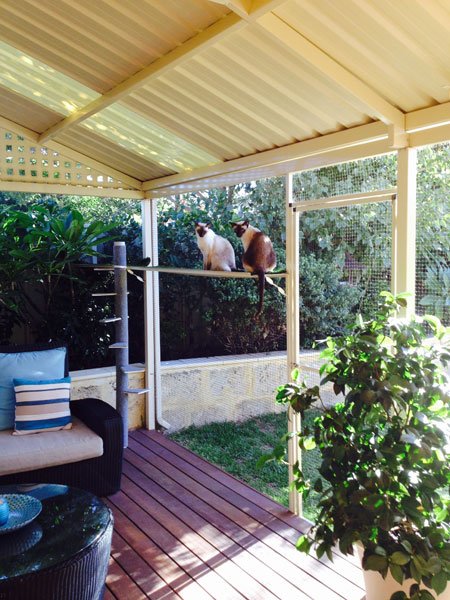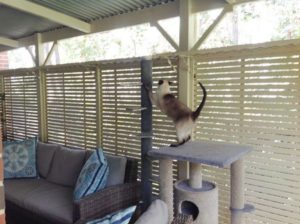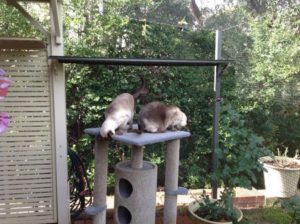Cat + Patio: Build your own “catio”

An awesome DIY for an outdoor patio, for cats.
It’s a known fact that the average life span of a cat with free access to roam outdoors is significantly shorter than those kept indoors. Car accidents, access to poisons, cat fights, dog attacks, snake bites and infectious diseases are just some of the deadly dangers that a free-roaming cat has to try and avoid.
But keeping cats exclusively indoors to protect them from theses dangers also comes with risks, and cats confined strictly to the indoors have a much higher incidence of stress-related diseases such as feline idiopathic cystitis, upper respiratory infections and gastrointestinal diseases such as inflammatory bowel disease. There’s also a much higher incidence of behavior disorders, such as inappropriate elimination, which, sadly, is the most common reason pet owners surrender a cat to a shelter.
The good news: An enclosed “catio”—an outdoor patio for cats that safely confines the cat to the owner’s property—allows cats to have the best of both worlds. They’re safely protected from the dangers of the outside world, all while still being able to express their normal feline behaviors.
The American Association of Feline Practitioners (AAFP) Welfare Committee has recently released a position statement, Impact of Lifestyle Choice on the Companion Cat—Indoor vs. Outdoor. This statement emphasizes that allowing cats the freedom for an indoor/outdoor lifestyle where the outdoor access is in a safe environment, such as an enclosed catio, provides the best option for emotional and physical wellbeing.

Photo courtesy of Martine van Boeijen
When designing a catio, it’s crucial to create an enriched environment to prevent boredom and behavior problems. Cats are territorial animals that like to be in control of their surroundings, so it’s beneficial to allow them to have free access to their catio via a cat flap or tunnel if applicable. If the household has more than one cat, consider placing two cat flaps to prevent one cat blocking access to the catio.
Provide plenty of vertical space in the catio in the form of ramps, hammocks, shelving and cat trees. Try to have some platforms or hammocks positioned to allow cats to be able to laze in the morning and afternoon sun, and ideally offer some at a reasonable height from ground level to give the cat a vantage point to observe the local bird life. Design the platforms at two or more different heights and connect them with walkways.
Scratching is a natural behavior for cats. It sharpens their claws, stretches muscles and leaves scent marks. Each catio should provide at least one scratching pole. For households with more than one cat, try to have at least as many scratching poles as there are cats.

Photo courtesy of Martine van Boeijen
Speaking of more than one cat, for those with more than one cat or for those with timid cats, create a number of hiding and escape areas to help cats feel safe. Carefully select nontoxic plants, such as catnip and cat grass, to place in the catio.
Make sure the catio has the cat’s basic resources, including fresh water, areas to eliminate —such as a sand box or litter box—and places to sleep comfortably. For spaces with more than one cat, always make sure there are multiple, separated key resources. For example, three cats require a minimum of four water bowls. Ensure the catio has protected, shaded areas and is well-ventilated to prevent odor build-up.
The optimum size of a catio will depend on the number of cats and how well they all get along with each other. For cats that also have free access to indoors, aim for at least two square meters of floor space for each cat, with a minimum height of two meters (around 6.5 feet), and then create vertical space and hiding locations to increase the available space further more.
Most cats adapt well to living indoors and in an enclosed “catio”, particularly if this is commenced from an early age. But some adult cats that have been used to roaming outdoors will require a bit of time to adjust to the smaller and more restricted territory.
Courtesy of DVM360. By Martine van Boeijen, BSc, BVMS, MANZCVSc (Medicine of Cats)All Catio photos courtesy of Martine van Boeijen, BSc, BVMS, MANZCVSc (Medicine of Cats)
- Behavior (11)
- Caring for your pet (263)
- cat (4)
- Community Events (19)
- dog (6)
- From Our Clients (15)
- Happy Tails (8)
- News (418)
- Press (53)
- Products (2)
- Questions (4)
- Recalls (1)
- Special Offers (5)
- Tips & Advice (231)
- Uncategorized (19)
- Veterinary Services (48)
